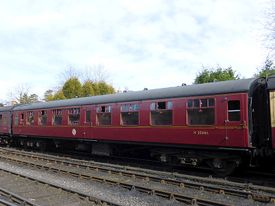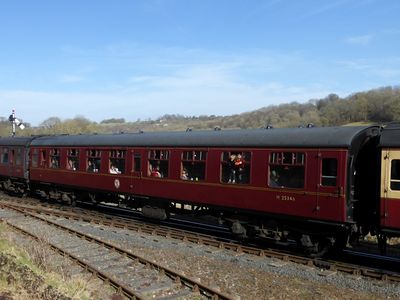BR 25346 Standard Corridor
| BR 25346 Standard Corridor | |
|---|---|
 BR Corridor Second 25346 | |
| Built By | BR Wolverton |
| Status | In service |
| Number | M25346 |
| Livery | BR Maroon |
| Other numbers | E25346 |
| History | |
| Built | 1957 |
| Diagram | 146 |
| Lot | 30349 |
| Type | SK |
| TOPS code | AA21 |
| Seats | 48 |
| 1982 | Entered preservation |
Contents
Service and preservation
25346 was built in 1957 at Wolverton to Diagram 146 (AA201), Lot 30349. As built, 25346 was fitted with Mk2 'Madison Modified' bogies with plain bearings, although it has since been fitted with standard bogies. It entered service in the London Midland region in August 1957, transferring to the Eastern region in June 1977.[3]
In 1982 BR's York Works were ordered to overhaul 200 Mark 1 vehicles. Having fallen behind with this work, by the time 25346's overhaul had been completed at a cost of more than £2,000, the new faster train services were being introduced and 25346 became one of a number of carriages to be withdrawn immediately after being outshopped. It was acquired from York by the L.M.S. & B.R. Coach Fund for just £1,100,[2] arriving on 21 July 1982.[1] At the time it was noted that despite being ex-works, it was suffering from a suspected burst roof tank, although this proved to be only a split vent pipe which was easily remedied.[4]
25346 entered service on the SVR in the InterCity blue and grey livery in which it was acquired. It was withdrawn from traffic on 3 August for a 12-day repaint at Bridgnorth into its original BR Crimson and Cream livery. Experimentally, automotive-type black lining tape was used to apply the lining in conjunction with the usual gold lining paint. This technique, which was similar to that used by BR for applying their blue and grey livery, proved a success and was adopted for other repaints.[5]
In spring 1988 the windows were re-bedded at Bridgnorth in anticipation of another repaint later in the year. The "heavy clean and quick repaint" was completed in time for the Autumn Steam Gala despite starting just 3 weeks before.[6]
25346 was one of several coaches "stopped" in 1999. During 2000 most of the body at the lavatory end was rebuilt at Bewdley, several doors were re-skimmed, all the windows resealed, the seats were fully reupholstered in new moquette, and most of the interior revarnished. The moquette was an experimental grey and pink design developed for First Great Western Railway but not subsequently taken up by them, with all sixteen rolls of the cloth being acquired by the SVR for use in the 1960s liveried coaches. The carriage was then repainted into 1960s BR Maroon livery at Kidderminster. 25346, which effectively seats 48, was transferred from Set C (BR Crimson and Cream) to Set M (BR Maroon) in order to increase the seating capacity in the Set C by exchanging it with TSO 4545 which seats 64. 25346 was outshopped at the end of February 2001 with 4545 taking its place in the paint shop for its repaint from Maroon into Crimson and Cream.[7][2]
In 2007 the L.M.S. & B.R. Coach Fund's carriages including 25346 were transferred into the ownership of the SVR Charitable Trust. Since that time, it has benefited from a slow-speed charger and new batteries at the Trust's expense.
By winter 2009-10 25346's wheels had become worn and required a wheelset change. The larger wheels in turn required the ride height to be adjusted by re-tensioning the springs on the bogies to ensure that the steps in gangways did not exceed the permitted amount. New bearing pads were also provided and brake rigging repairs carried out to eliminate wear. Repairs were made to the steam-pipe and a new set of overhauled Buckeye couplings were fitted.[8] Later in 2010 the carriage underwent its '10 year' overhaul at Kidderminster, which was completed just in time for that year's Santa duties.[9]
Its appearance was improved in mid-2016 by a "quick repaint".[10] In 2021 it received a new toilet floor.[11] It remains in BR Maroon livery as seen in this photograph in March 2015.
See also
References
Links
| ||||||||||||||||||||||||||||||
